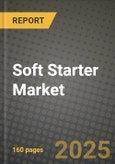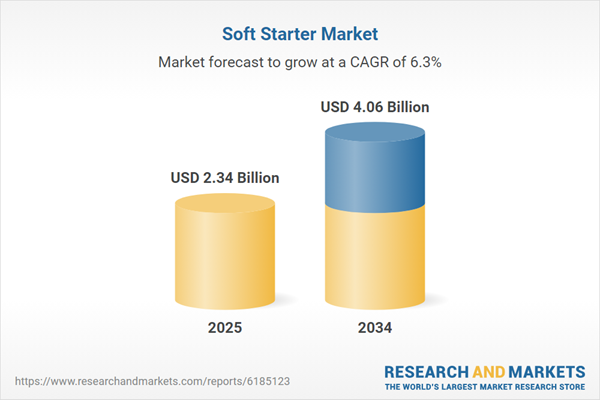Soft Starter Market
Soft starters are solid-state devices that limit inrush current and mechanical stress during AC motor start/stop, using phase-angle control and algorithms such as current limit, torque control, and pump-stop (anti-water-hammer). They serve fixed-speed applications where variable-frequency drives (VFDs) are not required, notably pumps, fans, compressors, conveyors, crushers, mixers, chillers, and hoists across water & wastewater, HVAC, mining & aggregates, oil & gas, chemicals, food & beverage, metals, pulp & paper, and marine. Adoption is propelled by the need to protect motors and driven equipment, reduce thermal/mechanical shocks on belts, couplings and pipes, and comply with utility rules on flicker and voltage dip. Trends include compact, built-in-bypass designs that cut heat and panel size; smart soft starters with event logs, thermal models, and condition monitoring; native Ethernet and fieldbus connectivity for PLC/SCADA and cloud diagnostics; and harmonics-conscious designs with better EMC. Buyers evaluate lifecycle value - startup performance, protection richness (phase loss, stall, jam), ease of commissioning, and diagnostics - alongside compliance to IEC/UL, marine approvals, and utility specifications. The competitive landscape spans global electrification majors and regional specialists offering low-voltage (LV) up to medium-voltage (MV) ranges, inside-delta configurations, and application-specific firmware (pump, conveyor, extruder). Differentiation centers on starting algorithms that minimize process transients, thermal capacity for high-inertia loads, integration with MCCs and motor protection relays, cybersecurity-aware Ethernet stacks, and support services from sizing to retrofit. While VFDs expand, soft starters continue to win in fixed-speed duty where simplicity, ruggedness, lower capex, reduced harmonic footprint, and smaller enclosures matter.Soft Starter Market Key Insights
- Fixed-speed value proposition endures. In applications with steady operating frequency, soft starters deliver motor/equipment protection and lower harmonics at materially lower cost and complexity than VFDs, preserving panel space and maintenance simplicity.
- Smart diagnostics reduce downtime. Embedded logs, real-time thermal modeling, QR/app-based commissioning, and alarms for jam, stall, underload, and voltage imbalance enable predictive maintenance and faster root-cause analysis for field technicians.
- Built-in bypass is mainstream. Thyristors handle ramp-up, then transfer to internal contactors, slashing heat losses and ventilation needs; this enables smaller MCC buckets, higher enclosure densities, and improved efficiency in continuous duty.
- Process-aware algorithms. Pump-stop, kick-start, torque-controlled ramps, and linear speed estimation mitigate water hammer, belt slip, and mechanical shocks, protecting seals, gearboxes, and pipework in critical process lines.
- Cybersecure connectivity. Native Ethernet/IP, Profinet, Modbus-TCP and web servers simplify integration; role-based access, password policies, and event trails address rising OT security expectations without sacrificing commissioning speed.
- MV and high-inertia loads. Medium-voltage soft starters with fiber-optic firing, multi-pulse bridges, and high-dV/dt withstand heavy mills, crushers, and long conveyors, offering a simpler alternative to MV drives in fixed-speed duty.
- Grid friendliness and power quality. Current-limit starts reduce voltage dip and flicker versus across-the-line; coordinated protection with soft-charge transformers and correct earthing improves selectivity and utility acceptance.
- Retrofit opportunities. Aging electromechanical starters are replaced by drop-in solid-state units that reuse existing MCC infrastructure; digital twins and sizing tools accelerate brownfield adoption across plants and water utilities.
- Panel builder ecosystem. Pre-engineered kits, thermal curves, and UL/IEC coordination data shorten certification cycles for OEMs and panel shops, turning soft starters into modular building blocks in standardized control cabinets.
- TCO over nameplate kW. Buyers balance capex, harmonic mitigation cost, enclosure size, cooling, uptime, and spare strategy; serviceability (field-replaceable fans/relays), global approvals, and warranty terms tip competitive bids
Soft Starter Market Reginal Analysis
North America
Replacement of contactor-based starters in water utilities, municipal HVAC, and building services sustains demand for LV units with built-in bypass and pump algorithms. Industrial users in aggregates, food, and midstream prefer rugged designs with clear diagnostics and PLC-friendly Ethernet. Utility flicker limits and arc-flash policies influence selection and MCC layouts. Service networks, spare availability during outages, and retrofit-friendly footprints shape awards; cybersecurity and remote commissioning features are increasingly specified.Europe
Emphasis on power quality, harmonics, and compact, energy-efficient panels favors soft starters in fixed-speed pumps, fans, and compressors within commercial buildings, district energy, and process plants. Strong adoption of smart MCCs and digital engineering workflows rewards products with detailed coordination files and digital twins. OEMs target IEC/EN compliance, marine/ATEX options, and robust EMC performance. Water infrastructure upgrades and industrial decarbonization projects open steady retrofit cycles for both LV and selected MV applications.Asia-Pacific
Rapid industrialization and urban water projects drive high volumes in pumps, blowers, and conveyors; price-performance and dealer coverage are decisive. In Australia and Southeast Asia, mining and aggregates require heavy-duty, dust-tolerant MV/LV units with high-inertia starting. Japan/Korea value compactness, reliability, and advanced protection; India and ASEAN prioritize easy commissioning, multilingual HMIs, and strong after-sales. Growing panel-builder ecosystems accelerate standardized soft-starter adoption in OEM equipment.Middle East & Africa
Desalination, district cooling, and large water transfer schemes create consistent demand for pump-optimized soft starters with low flicker and robust protections. In hydrocarbons and metals, MV units support crushers, compressors, and long conveyors under harsh ambient conditions; derating and enclosure engineering are critical. Buyers emphasize proven reliability, local service partners, and fast spare logistics. Utilities and EPCs increasingly specify remote monitoring for distributed assets.South & Central America
Water & wastewater upgrades, food processing, cement, and mining underpin procurement, with public tenders valuing compliance documentation and lifecycle support. Soft starters help stabilize starts on weak grids and gensets common in remote operations. Panel builders seek flexible mounting, clear coordination data, and multilingual interfaces. Financing options, local inventory, and training for maintenance teams influence vendor selection, while retrofit programs replace electromechanical starters with solid-state solutions across municipal and industrial sites.Soft Starter Market Segmentation
By End-User
- Mining & Metal
- Food & Beverages
- Energy & Power
- Oil & Gas
- Others
Key Market players
ABB, Siemens, Schneider Electric, Rockwell Automation, Eaton, Danfoss, WEG, Mitsubishi Electric, Toshiba, Fuji Electric, Carlo Gavazzi, Lovato Electric, Solcon-IGEL, AuCom Electronics, EmersonSoft Starter Market Analytics
The report employs rigorous tools, including Porter’s Five Forces, value chain mapping, and scenario-based modelling, to assess supply-demand dynamics. Cross-sector influences from parent, derived, and substitute markets are evaluated to identify risks and opportunities. Trade and pricing analytics provide an up-to-date view of international flows, including leading exporters, importers, and regional price trends.Macroeconomic indicators, policy frameworks such as carbon pricing and energy security strategies, and evolving consumer behaviour are considered in forecasting scenarios. Recent deal flows, partnerships, and technology innovations are incorporated to assess their impact on future market performance.
Soft Starter Market Competitive Intelligence
The competitive landscape is mapped through proprietary frameworks, profiling leading companies with details on business models, product portfolios, financial performance, and strategic initiatives. Key developments such as mergers & acquisitions, technology collaborations, investment inflows, and regional expansions are analyzed for their competitive impact. The report also identifies emerging players and innovative startups contributing to market disruption.Regional insights highlight the most promising investment destinations, regulatory landscapes, and evolving partnerships across energy and industrial corridors.
Countries Covered
- North America - Soft Starter market data and outlook to 2034
- United States
- Canada
- Mexico
- Europe - Soft Starter market data and outlook to 2034
- Germany
- United Kingdom
- France
- Italy
- Spain
- BeNeLux
- Russia
- Sweden
- Asia-Pacific - Soft Starter market data and outlook to 2034
- China
- Japan
- India
- South Korea
- Australia
- Indonesia
- Malaysia
- Vietnam
- Middle East and Africa - Soft Starter market data and outlook to 2034
- Saudi Arabia
- South Africa
- Iran
- UAE
- Egypt
- South and Central America - Soft Starter market data and outlook to 2034
- Brazil
- Argentina
- Chile
- Peru
Research Methodology
This study combines primary inputs from industry experts across the Soft Starter value chain with secondary data from associations, government publications, trade databases, and company disclosures. Proprietary modeling techniques, including data triangulation, statistical correlation, and scenario planning, are applied to deliver reliable market sizing and forecasting.Key Questions Addressed
- What is the current and forecast market size of the Soft Starter industry at global, regional, and country levels?
- Which types, applications, and technologies present the highest growth potential?
- How are supply chains adapting to geopolitical and economic shocks?
- What role do policy frameworks, trade flows, and sustainability targets play in shaping demand?
- Who are the leading players, and how are their strategies evolving in the face of global uncertainty?
- Which regional “hotspots” and customer segments will outpace the market, and what go-to-market and partnership models best support entry and expansion?
- Where are the most investable opportunities - across technology roadmaps, sustainability-linked innovation, and M&A - and what is the best segment to invest over the next 3-5 years?
Your Key Takeaways from the Soft Starter Market Report
- Global Soft Starter market size and growth projections (CAGR), 2024-2034
- Impact of Russia-Ukraine, Israel-Palestine, and Hamas conflicts on Soft Starter trade, costs, and supply chains
- Soft Starter market size, share, and outlook across 5 regions and 27 countries, 2023-2034
- Soft Starter market size, CAGR, and market share of key products, applications, and end-user verticals, 2023-2034
- Short- and long-term Soft Starter market trends, drivers, restraints, and opportunities
- Porter’s Five Forces analysis, technological developments, and Soft Starter supply chain analysis
- Soft Starter trade analysis, Soft Starter market price analysis, and Soft Starter supply/demand dynamics
- Profiles of 5 leading companies - overview, key strategies, financials, and products
- Latest Soft Starter market news and developments
Additional Support
With the purchase of this report, you will receive:- An updated PDF report and an MS Excel data workbook containing all market tables and figures for easy analysis.
- 7-day post-sale analyst support for clarifications and in-scope supplementary data, ensuring the deliverable aligns precisely with your requirements.
- Complimentary report update to incorporate the latest available data and the impact of recent market developments.
This product will be delivered within 1-3 business days.
Table of Contents
Companies Mentioned
- ABB
- Siemens
- Schneider Electric
- Rockwell Automation
- Eaton
- Danfoss
- WEG
- Mitsubishi Electric
- Toshiba
- Fuji Electric
- Carlo Gavazzi
- Lovato Electric
- Solcon-IGEL
- AuCom Electronics
- Emerson
Table Information
| Report Attribute | Details |
|---|---|
| No. of Pages | 160 |
| Published | November 2025 |
| Forecast Period | 2025 - 2034 |
| Estimated Market Value ( USD | $ 2.34 Billion |
| Forecasted Market Value ( USD | $ 4.06 Billion |
| Compound Annual Growth Rate | 6.3% |
| Regions Covered | Global |
| No. of Companies Mentioned | 15 |









